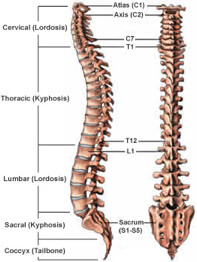Types of Scoliosis
There are different types and causes of scoliosis: idiopathic, congenital, syndromal, neuromuscular and degenerative. All ages can be affected by scoliosis, for example, idiopathic scoliosis can be early onset, age six years or less, or late onset after the age of six years, whereas degenerative scoliosis can occur in those usually over the age of 60 years.
Adolescent idiopathic scoliosis
The spinal column has a three-dimensional shape. From the front, it looks straight; from the side, there are normal curves. Scoliosis is an abnormal curving and twisting of the spine.
Who gets adolescent idiopathic scoliosis and what causes this?
Adolescent idiopathic scoliosis can occur in any young person. It is more common in girls than boys. It will often be first noticed during the rapid growth around the time of puberty. If the cause of the scoliosis is not known, it is called ‘idiopathic’. At present, there is some evidence that there is a genetic component to it and there is a family history in some cases. Identical twins have identical curves usually.


